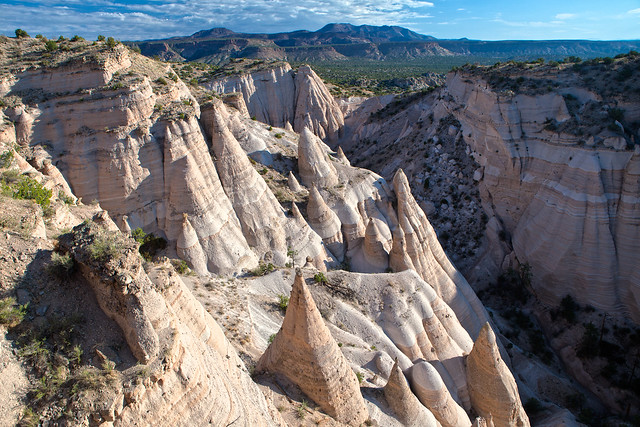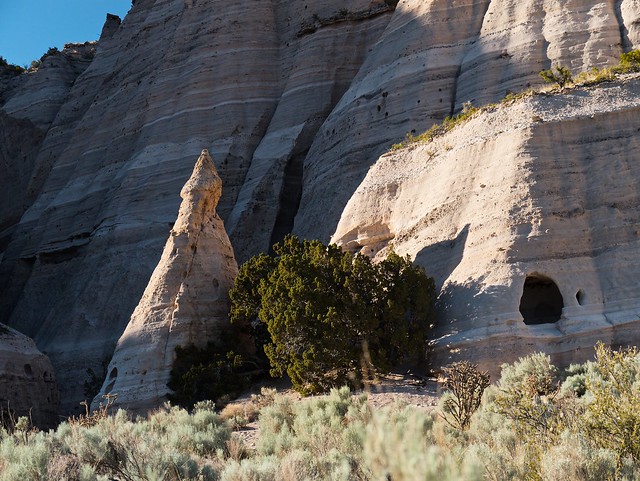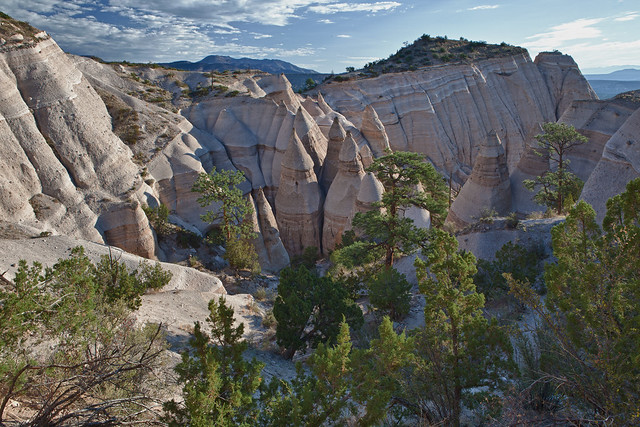Heavy ash clouds nearly black out the midday sky over northern New Mexico. Rocks, mostly composed of pumice and tuff, drop from the sky as small particles of ash slowly settle on top. It’s nearly seven million years ago, and a volcano in the Jimenez Volcanic Field has just erupted. When the last bits of volcanic debris settle, sedimentary layers as thick as one thousand feet have just been deposited, laying the foundation for what will later become a remarkable geologic wonder.
Tip: Use WalletFlo for all your credit card needs. It’s free and will help you optimize your rewards and savings!
Established as a US National Monument by President Bill Clinton in 2001, Kasha-Katuwe Tent Rocks National Monument is home to a collection of distinctive tent-shaped spires that represent the power and artistry of thousands of years of wind and water erosion.
“Kasha-Katuwe” actually means “white cliffs” in the Keresan language of the native people of Pueblo de Cochiti. To this day, the indigenous Cochiti people still inhabit the surrounding area with a vast ancestral connection thereto that dates back all the way to the fourteenth century.
Known for their hospitality, the Cochiti people also developed a reputation for their skilled craftsmanship in making jewelry and pottery. Many of these crafts have been revived from ancient times, such as the clay Storyteller pot, featuring a seated man with small children perched around the man’s shoulders and lap. Other common images depicted by artisans are turtles, birds, frogs, and lizards.
The Cochiti are perhaps most well-known for their drums, however. They take special care in selecting perfectly hollowed-out tree trunks, usually made of aspen, and using leather lacing to produce drums of excellent quality.
Like other sites nearby, a variety of interesting wildlife inhabit the Tent Rocks area. Mule deer, elk, mountain lions, and wild turkeys are found at the higher elevations, while chipmunks and coyotes can be spotted almost anywhere in the park.
Look to the sky and you may find a wide range of different birds, such as bluebirds, swallows, golden eagles, and red-tailed hawks. Red-tailed hawks are large, reddish-brown birds with broad, rounded wings, usually found circling high over fields or perched on trees or posts.
One of the most common hawks in North America, they can be spotted year-round and are one of the most-seen birds of prey if you are embarking on a long road trip through the United States. For many Native American cultures the feathers of the red-tailed hawk are considered sacred and are often used in religious ceremonies or featured as part of regalia, such as in colorful headdresses.
There are three scenic trails you can attempt at this monument, and, as with the rest of the Tent Rocks area, all of them are well maintained. The first option is the Cave Loop Trail, which is rated as easy and, at only 1.2 miles, can be completed in as short a time as thirty minutes. Many hikers aren’t overly impressed by the scenery, such as the small cave burrowed into the tan cliffside that you come across on this loop trail, which is why I recommend expending your energy on the more difficult Canyon Trail if you can handle it.
The Canyon Trail starts off by taking you through a beautiful slot canyon. Trekking along the grooves of the slot canyon and admiring the hoodoos on your way up to the top are noteworthy attractions in themselves. You’ll see firsthand and up close how wind and water over a span of millions of years sculpted the swirling terrain into such stunning formations.
After you get through the mostly flat terrain of the slot canyon, you’ll begin the steep 630-foot climb to the end of your destination. Some people find the final ascent a bit challenging, so be prepared for a bit of a workout. However, once you make it to the top of Canyon Trail, magnificent views of the Sangre de Cristo, Jemez, and Sandia Mountains plus the Rio Grande Valley stretch out before you. While the Canyon Trail is a bit tougher than the Cave Loop Trail, many visitors claim this trail is well worth the effort because of the amazing panoramic views available at the end. Expect the hike to take you between two and three hours to complete.
Finally, for a third option, there is the Veterans Memorial Trail, which is an easy one-mile loop trial that is wheelchair accessible.
Tips
- Flash floods can present a real danger here, so remain alert to the most current weather forecasts, especially if you are planning a visit during the summer monsoon season.
- Spring and fall make for the best time of year to visit.
- This is a religious site for the native locals, so be respectful of the land at all times.
- The trail can get crowded on weekends during the summer and on holidays, so plan on starting early if you are going during those times.
- There are no amenities inside the park, so bring your own food and water for your visit. However, on your way out, you might come across locals selling tacos, drinks, and fry bread, so be on the lookout for them if you are hungry.
Daniel Gillaspia is the Founder of UponArriving.com and the credit card app, WalletFlo. He is a former attorney turned travel expert covering destinations along with TSA, airline, and hotel policies. Since 2014, his content has been featured in publications such as National Geographic, Smithsonian Magazine, and CNBC. Read my bio.




